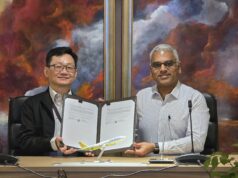CLARK FREEPORT – The Philippine Navy (PN) has urged the “immediate procurement” of multi-role vessels (MRV) as part of its “modernization and upgrade program” after one such vessel braved turbulent waters to transport 36 tons of relief goods to folk isolated by recent rains in Isabela province.
“The complexity of this kind of mission, underscores the need for the immediate procurement of the MRV as part of the Navy’s modernization and capability upgrade program. This vessel will not only enhance the Navy’s security efforts, but will also boost its capability in performing disaster and calamity related missions,” said Navy Col. Ariel Caculitan, acting director of the PN’s public affairs office.
Caculitan’s statement was issued after Aerotech Philippines, Inc, the local counterpart of the Italian aircraft manufacturer Alenia Aermacchi, turned over to the Philippine Air Force (PAF) four brand new SF-620 trainer aircraft, the first batch of 18 such aircraft to cost a total of P622.59 million intended to be delivered to the PAF up to April next year.
Caculitan said that “aside from a wide spectrum of traditional and non- traditional military operations, the MRV can serve as a Floating Government Humanitarian Center during times of calamities.”
“It can be a platform for medical treatment of calamity victims in isolated areas, accommodate a host of activities of Department of Social Welfare and Development (DSWD) and non-government organizations for the affected communities, springboard for disaster response and rescue operations (DRRO) teams, and other logistic and engineering supplies and equipment that are needed in response to the humanitarian emergency anywhere in the archipelago,” he noted.
The MRV measures 120 meters and can load up to 7,200 tons of cargo. It can accommodate 100 crew and 500 passengers and travels at a speed of 12 knots, he also noted.
Caculitan said that during the recent rains that trailed typhoon Juan, one such MRV dubbed LC 551, manned by marine and navy personnel, surged through rough seas and reached isolated folk in Divilacan, Isabela to whom they delivered 36 tons of food and other basic needs from United Nations Children’s Emergency Fund and the DSWD.
“The MRV also had a 60-man rescue team, a communications team, medical team, two payloaders, trailers, and a crane used for undertaking engineering and rehabilitation of various facilities,” he noted.
Caculitan also recalled that during typhoon Reming in November, 2006, only navy ships on mercy mission were able to reach isolated people in the Bicol region.
He also noted the role the navy played in helping people during the landslide in Ginsaugon, Leyte in February 2006.
“Unfortunately, the present inventory of naval vessels, limits the navy’s immediate delivery of services to victims of calamities in the country. The urgency of acquiring the MRV is often felt strongly during times when peoples’ lives and properties are in great danger,” Caculitan lamented.
“The complexity of this kind of mission, underscores the need for the immediate procurement of the MRV as part of the Navy’s modernization and capability upgrade program. This vessel will not only enhance the Navy’s security efforts, but will also boost its capability in performing disaster and calamity related missions,” said Navy Col. Ariel Caculitan, acting director of the PN’s public affairs office.
Caculitan’s statement was issued after Aerotech Philippines, Inc, the local counterpart of the Italian aircraft manufacturer Alenia Aermacchi, turned over to the Philippine Air Force (PAF) four brand new SF-620 trainer aircraft, the first batch of 18 such aircraft to cost a total of P622.59 million intended to be delivered to the PAF up to April next year.
Caculitan said that “aside from a wide spectrum of traditional and non- traditional military operations, the MRV can serve as a Floating Government Humanitarian Center during times of calamities.”
“It can be a platform for medical treatment of calamity victims in isolated areas, accommodate a host of activities of Department of Social Welfare and Development (DSWD) and non-government organizations for the affected communities, springboard for disaster response and rescue operations (DRRO) teams, and other logistic and engineering supplies and equipment that are needed in response to the humanitarian emergency anywhere in the archipelago,” he noted.
The MRV measures 120 meters and can load up to 7,200 tons of cargo. It can accommodate 100 crew and 500 passengers and travels at a speed of 12 knots, he also noted.
Caculitan said that during the recent rains that trailed typhoon Juan, one such MRV dubbed LC 551, manned by marine and navy personnel, surged through rough seas and reached isolated folk in Divilacan, Isabela to whom they delivered 36 tons of food and other basic needs from United Nations Children’s Emergency Fund and the DSWD.
“The MRV also had a 60-man rescue team, a communications team, medical team, two payloaders, trailers, and a crane used for undertaking engineering and rehabilitation of various facilities,” he noted.
Caculitan also recalled that during typhoon Reming in November, 2006, only navy ships on mercy mission were able to reach isolated people in the Bicol region.
He also noted the role the navy played in helping people during the landslide in Ginsaugon, Leyte in February 2006.
“Unfortunately, the present inventory of naval vessels, limits the navy’s immediate delivery of services to victims of calamities in the country. The urgency of acquiring the MRV is often felt strongly during times when peoples’ lives and properties are in great danger,” Caculitan lamented.



